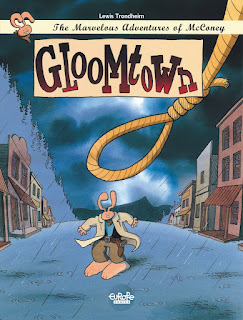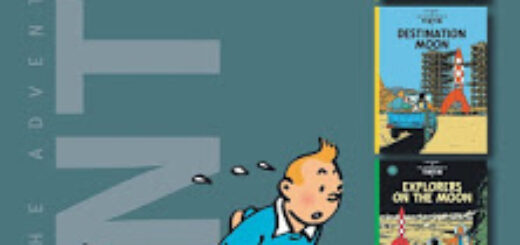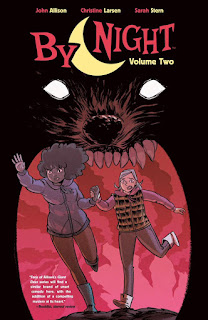The Adventures of Tintin, Vol. 6 by Herge
I forget, between volumes, just how much work it is to read the small-format Tintin omnibuses. Herge worked for a much larger page-size , and took advantage of that: his pages typically have at least a dozen panels, and are packed with dialogue that these editions set in a slightly fussy italic pseudo-handwritten font. So I find myself peering much more closely than I expect, and sometimes needing to take off my glasses to focus on on panel in isolation.
They’re also fairly involved, intricate stories: each one is 64 pages long, and, again, those are big pages full of talking and action. Sure, the talking is often vaudeville-level humor and the action is early-blockbuster spy thriller, but there’s still a lot of it. And a little bit of the supposedly humorous secondary characters – Jolyon Wagg, who first appears in these stories, I am looking straight at you – goes very far, but we never get just a little bit of them.
So perhaps I’m happy to be getting close to the end with The Adventures of Tintin, Vol. 6 . There’s something melancholic about reading old adventures stories from other people’s childhoods to begin with, and I’ve read fifteen previous adventures even before I got to this point. (Obligatory links to volumes one , two , three , four , and five , each of which reprinted three books. The first two in the series, Tintin in the Land of the Soviets and Tintin in the Congo, are mildly suppressed these days for reasons of tendentiousness and/or racism.)
Tintin, who was set up to be a boy reporter early in the series but never even feints in the direction of filing a story or having any kind of stable job by this point in the series, first appeared in 1929 at the age of twelve and, in the manner of adventure-story protagonists, was still twelve when The Calculus Affair first appeared in serialized form from 1954-56. (The other two books collected here are The Red Sea Sharks from 1956-58 and Tintin in Tibet from 1958-1959; this appears to be the point where Herge stopped working on Tintin stories basically continuously, at the age of about fifty-three, and did just three more discrete tales over the next decade-and-a-half.)
The three stories here are all entirely separate, though they have the standard Tintin furniture: Captain Haddock, Professor Calculus, those supposedly funny detectives, and so on and so on. Calculus and Red Sea are more-or-less spy thrillers: the first details a Cold War-ish battle between the standard two Herge fictional countries (Syldavia and Borduria) over a potential superweapon developed by guess-who, and the second is another one of Herge’s long-chain-of-coincidences plots that leads to Tintin foiling an operation to take African hajjis and sell them into slavery. (The book never uses the term “hajjis,” but they’re going to Mecca. Also, Herge’s drawing is a bit caricatured for the African characters, but he’s generally not racist in his depiction of them.)
Tibet is an odder book: Tintin has a prophetic dream about Chang, a boy of about the same age he met way back in the book The Blue Lotus, who has not been mentioned since, and who has supposedly just died in a plane crash in the Himalayas. Tintin is sure Chang is not dead, and has various omens that he is correct; the story is driven entirely by the boy’s pigheadedness and insistence on finding Chang. Oh, and there’s a Yeti in it , but mostly as a background character. It gets cited as a book about the power of friendship, but no real-world friendship I’m aware of includes ESP powers to infallibly rescue one another from far-away continents, so I’m a bit dubious.
Herge is still really good at adventure-story hugger-mugger; he throws additional complications in as well as anyone in the world. And his comic relief, though very hokey, is generally at least moderately amusing. (And that’s good, because these books are roughly forty percent comic relief by volume.) As I’ve said before, this is not exactly my thing, because I am an adult and because I grew up a generation or two later, but this is still really solid work and would probably be nearly as appealing to young people these days.
![]()
![]()
Reposted from The Antick Musings of G.B.H. Hornswoggler, Gent.

































































